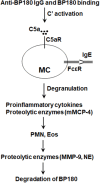The Autoimmune Skin Disease Bullous Pemphigoid: The Role of Mast Cells in Autoantibody-Induced Tissue Injury
- PMID: 29545809
- PMCID: PMC5837973
- DOI: 10.3389/fimmu.2018.00407
The Autoimmune Skin Disease Bullous Pemphigoid: The Role of Mast Cells in Autoantibody-Induced Tissue Injury
Abstract
Bullous pemphigoid (BP) is an autoimmune and inflammatory skin disease associated with subepidermal blistering and autoantibodies directed against the hemidesmosomal components BP180 and BP230. Animal models of BP were developed by passively transferring anti-BP180 IgG into mice, which recapitulates the key features of human BP. By using these in vivo model systems, key cellular and molecular events leading to the BP disease phenotype are identified, including binding of pathogenic IgG to its target, complement activation of the classical pathway, mast cell degranulation, and infiltration and activation of neutrophils. Proteinases released by infiltrating neutrophils cleave BP180 and other hemidesmosome-associated proteins, causing DEJ separation. Mast cells and mast cell-derived mediators including inflammatory cytokines and proteases are increased in lesional skin and blister fluids of BP. BP animal model evidence also implicates mast cells in the pathogenesis of BP. However, recent studies questioned the pathogenic role of mast cells in autoimmune diseases such as multiple sclerosis, rheumatoid arthritis, and epidermolysis bullosa acquisita. This review highlights the current knowledge on BP pathophysiology with a focus on a potential role for mast cells in BP and mast cell-related critical issues needing to be addressed in the future.
Keywords: autoantibodies; bullous pemphigoid; hemidesmosome; mast cells; skin autoimmunity.
Figures



Similar articles
-
Subepidermal blistering induced by human autoantibodies to BP180 requires innate immune players in a humanized bullous pemphigoid mouse model.J Autoimmun. 2008 Dec;31(4):331-8. doi: 10.1016/j.jaut.2008.08.009. Epub 2008 Oct 14. J Autoimmun. 2008. PMID: 18922680 Free PMC article.
-
Granulocyte-derived elastase and gelatinase B are required for dermal-epidermal separation induced by autoantibodies from patients with epidermolysis bullosa acquisita and bullous pemphigoid.J Pathol. 2004 Dec;204(5):519-27. doi: 10.1002/path.1674. J Pathol. 2004. PMID: 15538734
-
Immunopathology of bullous pemphigoid, an autoimmune and inflammatory skin blistering disease.Keio J Med. 2003 Jun;52(2):128-33. doi: 10.2302/kjm.52.128. Keio J Med. 2003. PMID: 12862365
-
Experimental models for the autoimmune and inflammatory blistering disease, Bullous pemphigoid.Arch Dermatol Res. 2007 Nov;299(9):417-22. doi: 10.1007/s00403-007-0790-5. Epub 2007 Sep 19. Arch Dermatol Res. 2007. PMID: 17879094 Free PMC article. Review.
-
The pathophysiology of bullous pemphigoid.Clin Rev Allergy Immunol. 2007 Oct;33(1-2):67-77. doi: 10.1007/s12016-007-0030-y. Clin Rev Allergy Immunol. 2007. PMID: 18094948 Review.
Cited by
-
New Insights Into the Pathogenesis of Bullous Pemphigoid: 2019 Update.Front Immunol. 2019 Jul 2;10:1506. doi: 10.3389/fimmu.2019.01506. eCollection 2019. Front Immunol. 2019. PMID: 31312206 Free PMC article. Review.
-
A case report of steroid-refractory bullous pemphigoid induced by immune checkpoint inhibitor therapy.Front Immunol. 2023 Jan 4;13:1068978. doi: 10.3389/fimmu.2022.1068978. eCollection 2022. Front Immunol. 2023. PMID: 36685586 Free PMC article.
-
Mast Cell Cytokines IL-1, IL-33, and IL-36 Mediate Skin Inflammation in Psoriasis: A Novel Therapeutic Approach with the Anti-Inflammatory Cytokines IL-37, IL-38, and IL-1Ra.Int J Mol Sci. 2021 Jul 28;22(15):8076. doi: 10.3390/ijms22158076. Int J Mol Sci. 2021. PMID: 34360845 Free PMC article. Review.
-
Role of the Pruritic Cytokine IL-31 in Autoimmune Skin Diseases.Front Immunol. 2019 Jun 21;10:1383. doi: 10.3389/fimmu.2019.01383. eCollection 2019. Front Immunol. 2019. PMID: 31281316 Free PMC article. Review.
-
Refractory Bullous Pemphigoid Successfully Treated with Reslizumab: A Possible Novel Therapeutic Modality.Ann Dermatol. 2023 May;35(Suppl 1):S103-S106. doi: 10.5021/ad.21.177. Ann Dermatol. 2023. PMID: 37853878 Free PMC article.
References
Publication types
MeSH terms
Substances
Grants and funding
LinkOut - more resources
Full Text Sources
Other Literature Sources
Medical

